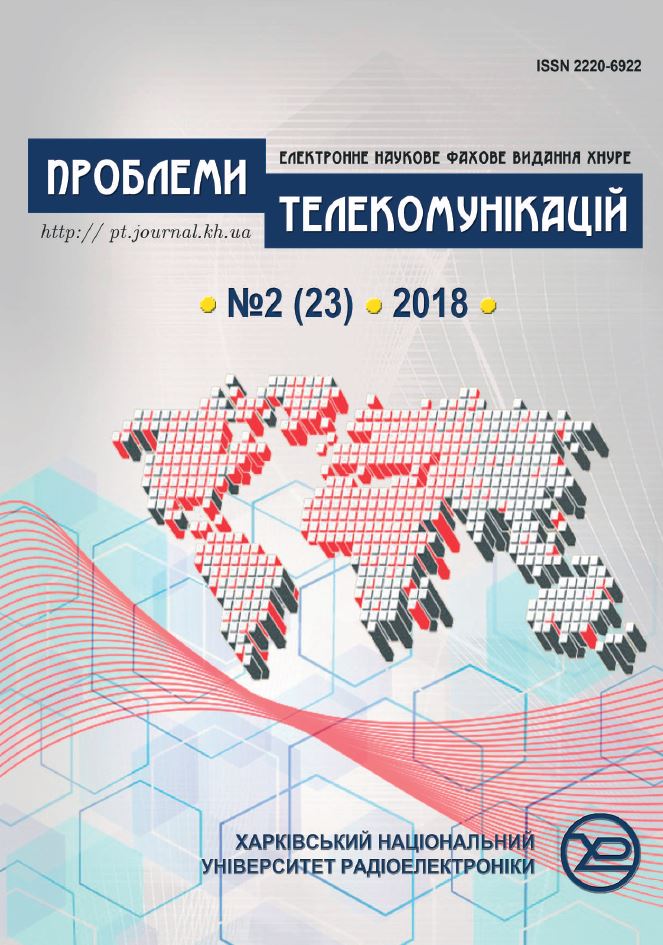Analysis of efficiency of space-time signal processing methods in mobile communication systems
DOI:
https://doi.org/10.30837/pt.2018.2.01Keywords:
Signal, Model, Antenna, Access, Signal-interfering environmentAbstract
The possibility of using recursive procedures in the space-time access problems as more constructive ones that perform correction of the weight vector of an antenna array in real time scale is considered, which is especially important for communication with mobile users. In order to evaluate the weight vector of the antenna array it has been proposed to use the optimal signal processing method in the space of Kalman-Bucy state variables, which allowed to achieve a stable mode of such processing on the action interval of the mobile stations’ call signals without changing the operating modes of the mobile communication network. A method is proposed that takes into account the a priori data about the direction of arrival of signals at the initial stage of the installation of the weight coefficient vector, which provides reduction of the convergence interval for the adaptation process of control algorithms and the required efficiency of the space-time processing of the adaptive antenna array. The influence of initial conditions on the installation of the weight vector on the characteristics of the quality of space-time processing of a linear 4-element adaptive antenna array under the influence of one and two obstacles for the LMSD and MOSN algorithms according to the signal/(interference+noise) is analyzed. It is shown that due to the successful initial selection of the value of the complex weight vector for a linear 4-element adaptive antenna array it has been possible to significantly improve the transient characteristics of the algorithms.References
Монзинго Р.А., Миллер Т.У. Адаптивные антенные решетки. Введение в теорию. – Москва: Радио и связь, 1986. – 448 с.
Баланис К.А., Иоанидес П.И. Введение в смарт-антенны.–Москва: Техносфера, 2012. – 200 с.
Коляденко Ю.Ю. Анализ эффективности алгоритмов адаптивных антенных решеток в линиях сотовой связи // Радиотехника. Всеукр. меж вед. научн.-техн. сб. – 2006. –Вып.144. – С.172-181.
Электромагнитная доступность источников радиоизлучений. Учебное пособие / Под ред. В. В. Поповского. – Ленинград: ВАС,1987.–2 62 с.
Коростелев А.А. Пространственно-временная теория радиосистем: учебное пособие для вузов.–Москва: Радио и связь, 1987. – 320 с.
Марков Г.Т., Сазонов Д.М. Антенны. – Москва: Энергия, 1975. – 528 с.
Вендик О.Г., Парнес М.Д.Антенны с электрическим сканированием. – Москва: Радиотехника, 2001. – 352 с.
Караваев В.В., Сазонов В.В. Статистическая теория пассивной локации. – Москва: Радио и связь, 1987. – 240 с.
Ширман Я.Д., Манжос В.Н. Теория и техника обработки радиолокационной инфор-мации на фоне помех. – Москва: Радио и связь, 1981. – 416 с.
Пространственно-временная обработка сигналов/Под ред. И. Я. Кремера. – Москва: Радио и связь, 1984. – 224 с.
Уидроу Б., Стирнз С. Адаптивная обработка сигналов. –Москва: Радио и связь,1989. – 440 с.
Марковская теория оценивания в радиотехнике / Под ред. М. С. Ярлыкова.–Москва: Радиотехника, 2004. – 504 с.
Родимов А.П., Поповский В.В.Статистическая теория поляризационно-временной обработки сигналов и помех. –Москва: Радио и связь, 1984. – 272 с.
Jovanović A., Lazović L., Rubežić V.Adaptive Array Beamforming Using a Chaotic BeamformingAlgorithm // Hindawi Publishing Corporation. International Journal of Antennas and Propagation. – Volume 2016. – Article ID 8354204. – P. 1-8. http://dx.doi.org/10.1155/2016/8354204.
Shahab S.N., Zainun A.R., Ali H.A., Hojabri M., Noordin N.H. MVDR algorithm based linear antenna array performance assessment for adaptive beamforming application // Journal of EngineeringScience and Technology. – 2017. – Vol. 12, No. 5. – Р. 1366 – 1385.
Senapati A., Roy J.S. Adaptive Beamforming In Smart Antenna Usingt Chebyscheff Distribution And Variants Of Least Mean Square Algorithm // Journal of Engineering Science and Technology. – 2017. –Vol. 12, No. 3. – Р. 716-724.
Singh H., Jha R.M. Trends in Adaptive Array Processing // Hindawi Publishing Corporation International Journal of Antennas and Propagation. – 2012, Article ID 361768. – Р. 1-20. doi:10.1155/2012/361768.
Sharma S.K., Patwary M., Chatzinotas S.Multiple Access Techniques for Next Generation Wireless: Recent Advances and Future Perspectives // EAI Endorsed Transactions on Wireless Spectrum. – 2016. – Vol.2,Issue 7. – Р. 1-12.
Song X., Wang F., Wang J., Ren J. Robust Recursive Algorithm under Uncertainties via Worst-Case SINR Maximization // Journal of Electrical and Computer Engineering Volume. – 2015. – Article ID458521. – Р. 1-8. http://dx.doi.org/10.1155/2015/458521.
Flaksman A. G., Sorokin I. S., Ermolayev V. T. Regularized estimate of the weight vector of an adaptive antenna array// Radiophysics and Quantum Electronics.–2013.–Vol. 55,Issue 9. – Р. 578–586. https://doi.org/10.1007/s11141-013-9395-3.
Downloads
Published
Issue
Section
License
Copyright (c) 2018 Moskalets Nickolai Vadіmovіch

This work is licensed under a Creative Commons Attribution-NonCommercial-ShareAlike 4.0 International License.
Authors who publish with this journal agree to the following terms:- Authors retain copyright and grant the journal right of first publication with the work simultaneously licensed under a Creative Commons Attribution License that allows others to share the work with an acknowledgment of the work's authorship and initial publication in this journal.
- Authors are able to enter into separate, additional contractual arrangements for the non-exclusive distribution of the journal's published version of the work (e.g., post it to an institutional repository or publish it in a book), with an acknowledgment of its initial publication in this journal.
- Authors are permitted and encouraged to post their work online (e.g., in institutional repositories or on their website) prior to and during the submission process, as it can lead to productive exchanges, as well as earlier and greater citation of published work (See The Effect of Open Access).

